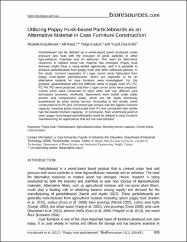Utilizing Poppy Husk-based Particleboards as an Alternative Material in Case Furniture Construction
Abstract
Particleboard can be defined as a wood-based panel produced under pressure and heat with the inclusion of wood particles or other lignocellulosic materials and an adhesive. The need for alternative resources to replace wood raw material has emerged. Poppy husk biomass might have a value-added opportunity, and it is possible to produce particleboards from poppy husk and other softwood species. In this study, moment capacities of L-type corner joints fabricated from poppy husk-based particleboards, which are expected to be an alternative material for case furniture, were investigated. For this purpose, particleboards with five different ratios of poppy husk (P1, P2, P3, P4, P5) were produced, and then L-type corner joints were prepared. Corner joints were connected to each other with two different joint techniques (screwed, minifixed). Specimens were tested under static tension and compression loads, which are the loads commonly experienced by joints during service. According to the results, joints constructed from P5 and connected with screws had the highest moment capacity, whereas joints constructed from P1 and connected with minifix had the lowest moment capacity. In conclusion, from a technical point of view, poppy husk-based particleboards could be utilized in case furniture manufacturing for applications that are not overstressed.


















